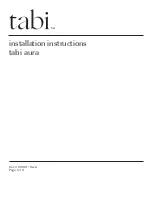
7-6
Chapter 7 Synchronized Operations
Chapter 7
7-2 Time Code Chase
7-2-4 Chase Modes
Time code chase operation sequence
common to the two chase modes
The following flowchart illustrates the time code chase
operation sequence.
Using fast forward and rewind, position the
tape immediately before the desired position
(locate operation).
↓
Using variable speed playback (vari-sync
playback), synchronize the playback time code
phase with the external time code phase (phase
synchronization).
↓
End synchronization
In both address mode and free mode, the
synchronization with the external time code is accurate
to
±
1/100 frame (
±
1 subframe), but once the
synchronization is achieved, operation in the two
modes is different.
Address mode
In this mode, once the synchronization with the
external time code is achieved, until the STOP button
or TC CHASE button is pressed, the
unit maintains
phase synchronization with the external time code.
Even if the external time code playback speed is
varied, provided the variation is within
±
12.5% of the
standard playback speed, the
synchronization is
maintained.
This mode is appropriate when the external time code
is supplied continuously and with no defects or errors.
In this mode there are three operation windows used to
specify the error range for which re-synchronization is
carried out, the variation range for vari-sync playback,
and so forth.
For details see “7-2-5 Time Code Chase Operation
Windows” (page 7-8) .
Free mode
In this mode, after the initial synchronization with the
external time code is achieved, the time code chase
function terminates. Thereafter the unit returns to
normal playback.
This mode is appropriate when the external time code
contains discontinuities or errors.
For example, if synchronizing the slave and master
units to an external composite video signal, by
carrying out the time code chase operation in the free
mode, once the slave unit and master unit time codes
are synchronized, even if the master unit time code
contains discontinuities, the synchronization is
maintained by the composite video signal.
In free mode, if the PCM-3348HR SYNC CLOCK
switch is set to EXT or DI, during time code chase
operations the SYNC CLOCK switch automatically
switches to INT, and after synchronization with the
external time code, switches back to EXT or DI.
Thereafter, the slave unit synchronization is
maintained by the external word sync signal or AES/
EBU digital audio signal.
Summary of Contents for PCM-3348HR
Page 8: ...1 2 Chapter 1 Overview Chapter 1 ...
Page 86: ...4 32 Chapter 4 Basic Operations of the RM 3348HR Remote Control Unit Chapter 4 ...
Page 114: ...5 28 Chapter 5 Time Shift Editing Using the Sound Memory Chapter 5 ...
Page 126: ...6 12 Chapter 6 Digital Copy Chapter 6 ...
Page 142: ...7 16 Chapter 7 Synchronized Operations Chapter 7 ...
Page 172: ...10 16 Chapter 10 External Synchronization Chapter 10 ...
















































